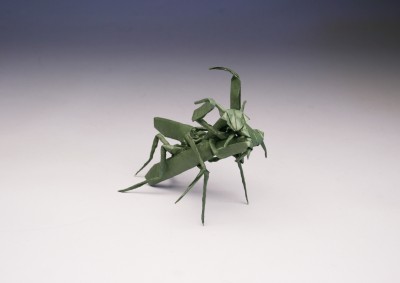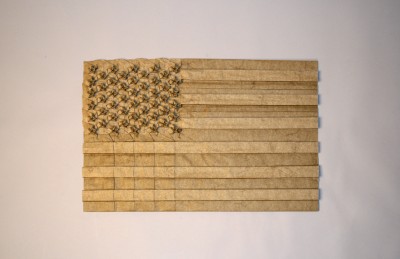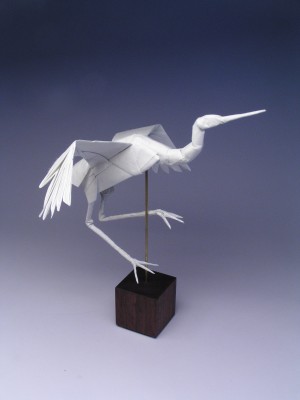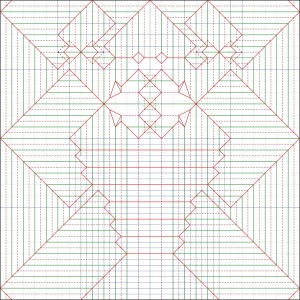Robert J. Lang | Origami Artist
June 17 through August 30, 2014

Snack Time, opus 527
Composed: 2007, Folded: 2007
One uncut square of Hiromi paper; 7”
Designed and folded for a private commission
Image courtesy of Gary Cornell

Stars and Stripes, opus 500
Composed: 2007, Folded: 2007
One uncut square of Wyndstone Marble paper; 13×17”
Commissioned by the New York Times Magazine for an article on the greening of America
Image courtesy of Robert J. Lang
(Pasadena, Calif.) June 12, 2014 – Robert J. Lang, one of the world’s foremost origami artists, and his intricate work is celebrated in a new exhibition opening at Art Center College of Design on June 17 and continuing through August 30, 2014. Folded: The Origami Art of Robert J. Lang, is co-curated by Meher McArthur, Asian art curator, author and educator, and Stephen Nowlin, director of the Alyce de Roulet Williamson Gallery at Art Center. Folded opens on June 17 and continues through August 30, 2014. The opening night reception on Thursday, June 19 from 7 p.m. until 9 p.m. is free and open to the public. For more information, visit http://williamsongallery.net/folded.
Lang, a former physicist, is recognized as one of the world’s leading masters of the art, with more than 600 designs catalogued and diagrammed. His work is noted for its great detail and realism and includes some of the most complex origami designs ever created.
The exhibition, featuring more than 50 of the artist’s works from his own collection, museum and private collections, is the first overview of Lang’s work as an origami artist and will demonstrate how he has been pushing the boundaries of this art form.
After graduating from the California Institute of Technology (Caltech), Lang worked as a physicist, engineer and R&D manager at NASA’s Jet Propulsion Laboratory, and at private companies and laboratories in Silicon Valley. He has authored or co-authored more than 80 technical publications and holds 50 patents on semiconductor lasers, optics and integrated optoelectronics. After 30 years of studying origami as his passion, Lang gave up his day job as a laser physicist to focus on both the art and science of origami.
His work combines aspects of the Western school of mathematical origami design with the Eastern emphasis on line and form to yield models that are at once distinctive, elegant and challenging to fold. His models have been shown in exhibitions in New York (Museum of Modern Art), Paris (Carrousel du Louvre), Salem (Peabody Essex Museum), San Diego (Mingei International Museum) and Kaga, Japan (Nippon Origami Museum), and featured in documentary films, television commercials and as a Google doodle.
As an origami artist, Lang has pushed origami in several different stylistic directions such as super-complex models of living creatures, intricate geometric forms and patterns, paper structures inspired by ceramic vessels, wall pieces created using crease patterns of his designs, and large-scale installation work. He has pioneered several new methods for creating artwork from folded paper using computer software to produce folding designs, laser scoring machines to mark folding lines, and writing computer codes to render origami designs using 3D printing. For example, he cast some of his origami forms in bronze in collaboration with a sculptor. He also teamed up with a photographer to fold floral photographs into 3D sculptures of flowers. The Williamson exhibition will feature some of Lang’s rarely seen super-complex models, including Snack Time, which depicts a female praying mantis devouring her mate (all folded from a single square of paper), as well as examples of his wall-mounted crease patterns and his recent cross-media innovations.

Dancing Crane, opus 460
Composed: 2005, Folded: 2005
One uncut square of Korean hanji; 9”
Image courtesy of Robert J. Lang
Co-curator Meher McArthur is the former curator of East Asian art at the Pacific Asia Museum in Pasadena, where she curated more than 15 Asian art exhibitions. She is currently an independent Asian art curator, author and educator. Her recent traveling exhibition Folding Paper: The Infinite Possibilities of Origami is touring the United States with International Arts & Artists (www.artsandartists.org) through 2016 and a sequel exhibition, Above the Fold: New Expressions in Origami, will begin a tour in 2015. Her publications include Reading Buddhist Art: An Illustrated Guide to Buddhist Signs and Symbols, The Arts of Asia: Materials, Techniques, Styles, An ABC of What Art Can Be, Confucius: A Throneless King, and Folding Paper: The Infinite Possibilities of Origami (co-authored with Robert J. Lang). She is also a regular contributor to KCET Artbound, writing about Asian artistic influence in Southern California.
Co-curator Stephen Nowlin is director of Art Center’s Williamson Gallery, where he has emphasized the intersection of art and science. Exhibitions include PAGES, examining the book page as a space for communicating as well as forging new ideas; WORLDS, an art-based perspective on earth and the solar system; ENERGY, a composite of objects and artifacts addressing the poetry of natural forces; TOOLS, focusing on artifacts from the artificial extension of human biology; OBSERVE, a collaboration with five contemporary artists and the NASA/JPL Spitzer Science Center; In the Dermisphere, surveying the art and natural history of skin; EAR(th), a sound installation with artist Steve Roden and Caltech geophysicist Mark Simons; and NEURO, a collaboration with the Center for Neuromorphic Systems Engineering at Caltech. Nowlin was the subject of a recent

Crease Pattern for Aedes aegypti, opus 619
Composed: 2012; Printed 2013/2014
Giclee Print on Canvas
Image courtesy of Robert J. Lang
The Williamson Gallery is located at Art Center’s hillside campus, 1700 Lida Street in Pasadena; hours are noon to 5 p.m., Tuesday through Sunday, with extended hours on Fridays, until 9 p.m. The gallery is closed Mondays and holidays. For more gallery information, call (626) 396-2446.
About the Alyce de Roulet Williamson Gallery The Alyce de Roulet Williamson Gallery at Art Center College of Design opened in 1992, and has since represented a unique voice in Pasadena and beyond, engaging art and ideas of both local and international significance. Pasadena is unequalled worldwide for its convergence of the arts and sciences, and the Williamson Gallery has embraced the exploration of that core identity as one of its primary programmatic goals. Offering students and the public an opportunity to form authentic and critical insights based upon first-hand experiences with the arts, the Williamson Gallery seeks out projects that will resonate deeply with the tenor of our times, provoke intellectual dissonance, and conjure unexpected pathways of thinking.
About Art Center College of Design Founded in 1930 and located in Pasadena, California, Art Center College of Design is a global leader in art and design education. Art Center offers 11 undergraduate and six graduate degrees in a wide variety of visual and applied arts as well as industrial design disciplines. In addition to its top-ranked academic programs, the College also serves members of the Greater Los Angeles region through a highly regarded series of year-round educational programs for all ages and levels of experience. Renowned for both its ties to industry and social impact initiatives, Art Center is the first design school to receive the United Nations’ Non-Governmental Organization (NGO) status. Throughout the College’s long and storied history, Art Center alumni have had a profound impact on popular culture, the way we live and important issues in our society.